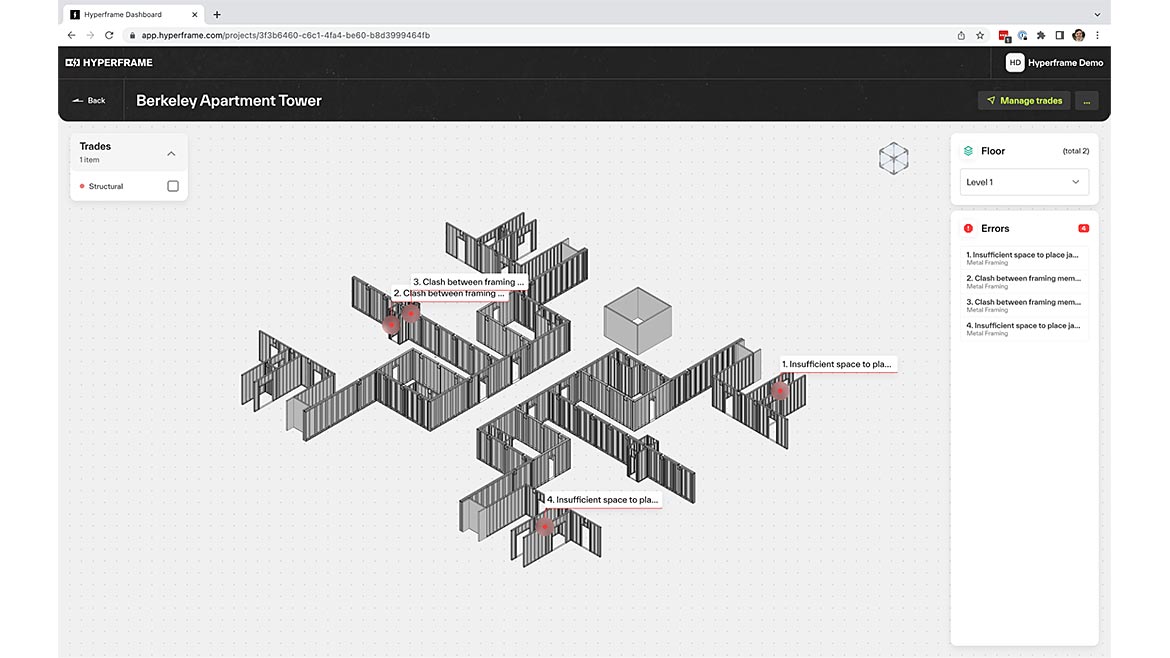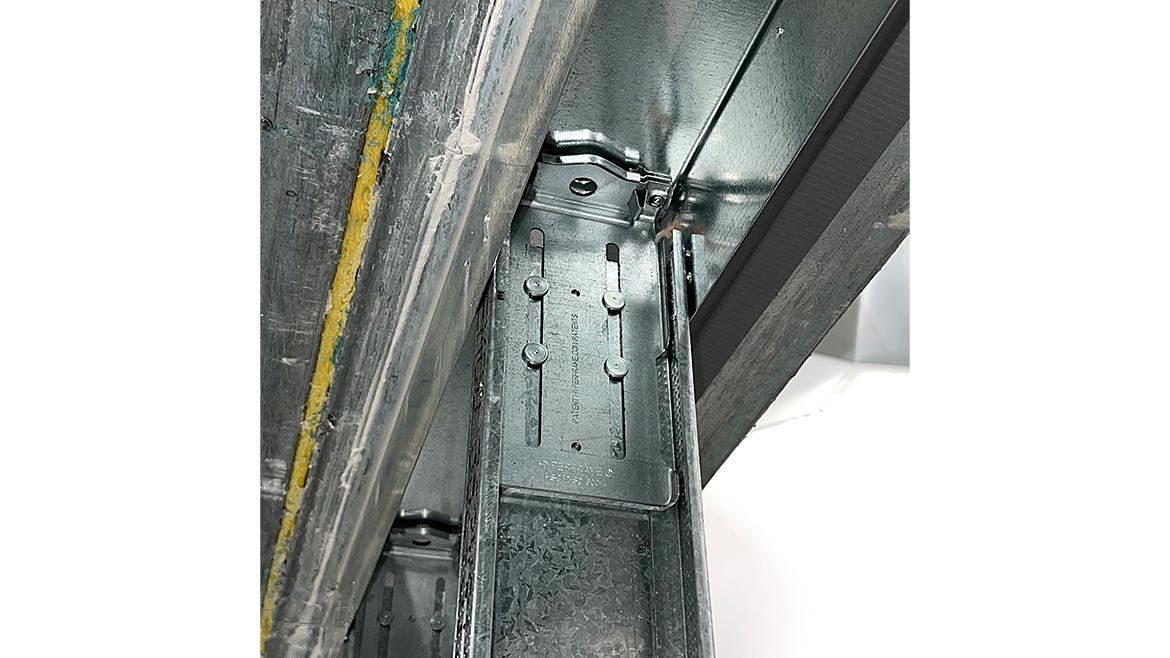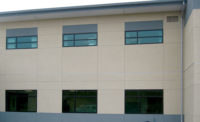Building Information Modeling has developed a complicated reputation in the metal stud framing industry. For every contractor who swears by it, another is perplexed by it. However, these are early days. As the next generation of BIM becomes smarter and easier to use, productivity and quality in the field are positioned to flourish.
What is BIM?
BIM is the process through which building designers create digital, three-dimensional models of building structures. Architects were the first to see the benefits. Modeling in 3D made it easier to visualize their designs. Moreover, BIM revolutionized drafting departments by automatically generating 2D drawing sets from the 3D model. By the mid-2000s, BIM became the most efficient way for architects to communicate their design intent, and Revit emerged as their BIM software of choice.
The Promise of BIM 1.0
General contractors saw a grander opportunity. By augmenting the architects’ BIM file with construction trade data, it would be possible to develop a “supermodel” or “digital twin” that matched the final construction design of the building. The supermodel would expose every possible clash and constructability issue in advance, allowing each trade to adjust and optimize their construction plans before they began work in the field. This process, called BIM coordination, had the potential to reduce field clashes, out-of-sequence work, rework and cost.
The practice of BIM coordination has flourished over the past 15 years. BIM has become the standard on complex projects, particularly hospitals, where clashes are expensive to resolve in the field. MEPF trades have capitalized on the trend, persuading GCs to award contracts earlier so that they can join the BIM coordination process sooner. They’ve used BIM as a tool to reduce risk, maximize efficiency and boost margin.
For metal stud framing contractors, BIM has been a mixed bag of frustration and promise. The MEPF trades oftentimes start and complete BIM coordination before the GC awards the metal stud framing contract. Framing complexities are often overlooked, and the MSF contractor is left holding the bag—expected to just “make it work” in the field, designing custom framing around every other trade.
For MSF contractors who participate in BIM coordination, it has required patience to realize the benefits. Learning how to use Revit framing plug-ins can take months. Configuring the framing settings for a new project can take days. Populating framing members into the BIM can take an hour per floor. Identifying constructability issues can take weeks and months as the BIM coordination process evolves.
This era will come to be known as BIM 1.0. It was an imperfect process using imperfect tools. Nevertheless, it has created the structure, willpower and inter-trade cooperation needed to make BIM more effective in the future.
BIM 2.0 Will Modernize and Streamline the Process
If you asked a BIM 1.0 designer to create a LOD 400 framing model, they’d laugh at you.
Level of Development is the standard scale for the completeness and accuracy of the BIM, ranging from 100 to 500. Today, most MSF BIM departments stop at LOD 350, where only critical framing is modeled (the remainder is either excluded or imprecisely positioned). An LOD 350 framing model might take weeks or months of computer modeling effort, depending on the scale of the building. LOD 400 has enough detail to drive total prefabrication. But, for most contractors using BIM 1.0 tools, the amount of computer modeling labor required to achieve LOD 400 is economically infeasible.
Why does LOD 350 take so long? Because BIM 1.0 Revit plug-ins feel like 1990s computer software. Complicated, stupid and slow.
New BIM 2.0 software will make it possible to achieve LOD 400 in minutes. That starts with ease of use. It will be so intuitive that new modelers will become productive on Day 1. In addition, it will be fast so that modelers don’t waste half their day waiting for the model to load. These features aren’t just “nice to haves.” They’re table stakes.
Artificial Intelligence presents an even bigger opportunity. Your framing software will become your in-house preconstruction expert, automatically modeling every condition to perfection. It will recommend the most economical wall design that satisfies the architect’s structural, fire and acoustic requirements. It will automatically select framing profiles that meet limiting height and span chart criteria. It will position layout studs for the optimal drywall configuration. Moreover, it will automatically detect unbuildable conditions, creating a punch list of discussion points for your next coordination meeting.
These features have the potential to deliver on BIM’s original promise. BIM 2.0 will become a tool that benefits every MSF project, no matter how large, small, simple or complex.

Figure 2: BIM 2.0 software automatically flags unbuildable MSF conditions so that they can be resolved with the MEPF trades before construction begins.
New Framing Products to Capitalize on BIM 2.0
Progressive MSF contractors have seen success in applying BIM to prefabricated exterior wall panels. Why has prefab succeeded in exterior framing? Reason one: they are easy to coordinate to LOD 400. Reason two: crane access is readily available to swing panels into position. Reason three: deviations between the BIM and as-built conditions have minimal impact on the fit-up of curtain walls.
Interiors have proven to be a different animal. They are much more difficult to coordinate with the MEPF trades. Prefabricated panels are very difficult to maneuver into the interior of the building. And, the fit-up is highly constrained by the height and levelness of the floor and deck slabs. So far, these barriers have prevented interior prefabrication from taking hold. As a result, MSF contractors have continued to stick-frame the old way.
BIM 2.0 will solve the coordination problem. To solve the fit-up problem, manufacturers are developing “smart studs” that telescope to the as-built deck height and snap into position – eliminating hours of custom cutting, fitting and screwing. They will be kitted by zone and loaded into the building via man lift, making stocking efficient and practical. When combined with BIM 2.0, “smart studs” will supercharge quality and productivity for interior MSF contractors.

Figure 3: Prefabricated “smart studs” will telescope to the as-built deck height and snap into position, yielding dramatic productivity.
Interiors have proven to be a different animal. They are much more difficult to coordinate with the MEPF trades. Prefabricated panels are very difficult to maneuver into the interior of the building. And, the fit-up is highly constrained by the height and levelness of the floor and deck slabs. So far, these barriers have prevented interior prefabrication from taking hold. As a result, MSF contractors have continued to stick-frame the old way.
BIM 2.0 will solve the coordination problem. To solve the fit-up problem, manufacturers are developing “smart studs” that telescope to the as-built deck height and snap into position – eliminating hours of custom cutting, fitting and screwing. They will be kitted by zone and loaded into the building via man lift, making stocking efficient and practical. When combined with BIM 2.0, “smart studs” will supercharge quality and productivity for interior MSF contractors.
Preparing for BIM 2.0
The BIM 1.0 workflow that our industry uses today is just a first act. It’s important for the MSF contractor to evaluate where BIM 2.0 technology is heading and actively seek opportunities to pilot BIM 2.0 technologies. It won’t just transform the way we construct buildings. It will transform the business models of the companies who build them.






Report Abusive Comment